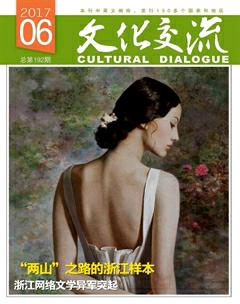架起“一带一路”的文化之桥
徐继宏


要想阅读历史就要走进博物馆。中国丝绸博物馆赵丰馆长说,“一带一路”建设,应该先讲好丝绸之路故事,这有助于推动浙江文化走出去、国外优秀文化引进来。
文博的天地、学术的殿堂,中国丝绸博物馆刚刚度过25周年馆庆。
记得有哲人说过,要想阅读历史,就走进博物馆;无论它是综合的,还是专业的。受这样的影响,笔者与赵丰馆长相约,就围绕“一带一路”架起文化沟通的桥梁作深度交谈。在小桥流水、传统时尚的中国丝绸博物馆,我们聊丝绸之路,也聊丝路之绸的过去、现在、未来……
国际丝绸之路日
作为连续两届全国人大代表,赵丰每年都在两会上提一些建议,与文化遗产保护有关,与丝绸、丝绸之路有关。他说:“我是研究丝绸的学者,从业30多年,对于丝绸一直有着一个复兴的梦。”
2013年,中国领导人向世界提出共建“一带一路”倡议,得到国际社会的高度关注和认可。2014年6月22日,由中国、哈萨克斯坦和吉尔吉斯斯坦联合申报的“丝绸之路:起始段—天山廊道的路网”项目通过审议,正式列入联合国科教文组织的《世界遗产名录》。
赵丰说,丝绸之路是一个起源于中国、由国外学者提出、由国际组织认可的概念,因此自己提议设立“国际丝绸之路日”,这可在国际社会表明中国作为丝绸之路的主体,具有一定的担当与责任,也为日后的拓展起到促进作用。“6月22日是丝绸之路跨国申遗成功之日,说明丝绸之路是大家的丝绸之路,具有较大的号召力。”
赵丰认为,“一带一路”建设,文化应该先行。讲好丝绸之路故事,有助于夯实“一带一路”的民意基础,有助于达到“一带一路”的民心相连。在2017年两会上,赵丰再次建议设立“国际丝绸之路日”。他亟盼在2017年“一带一路”国际合作高峰论坛上,由中国政府联合出席国家政府共同提出倡议,写入共识。他具体设想,设计一个“国际丝绸之路日”标志;率先与哈萨克斯坦、吉尔吉斯斯坦共同策划和连续实施系列主题以及配套活动,从而得到“一带一路”沿线国家的认可、支持与参与。在他看来,借助“国际丝绸之路日”的设立,是整合和协调“一带一路”的相关举措,对打造“一带一路”国际平台可以起到举重若轻的作用。
丝路之绸
交谈中,笔者首次听到赵丰提出一个“丝路之绸”的概念,即以丝绸及纺织服饰文化遗产为核心,参与“一带一路”相关的文化建设。
赵丰介绍,近年来,从遗产保护、大型展览和学术会议,到文化交流合作机制建设和文化产业建设,中国丝绸博物馆走出了一片广阔而光明的天地。《敦煌丝绸艺术全集》出版和敦煌丝绸修复项目、马圈湾出土汉代丝绸研究项目、俄罗斯北高加索地区出土丝绸研究项目……中国丝绸博物馆不仅参与了丝绸之路沿线的遗产的保护以及其他相关世界遗产的保护,还承担了赴俄罗斯、德国、土耳其等十多个国家的中国文化中心举办丝绸展览的工作。
近两年,随着新馆改扩建的完成,中国丝绸博物馆打造了“互联网+丝绸文明(丝绸之路)”、参与了“一带一路”文博产业繁荣计划,从教育和文创两方面开展中华丝绸文明价值挖掘及传播服务示范等工作。中国丝绸博物馆还积极参与到文化交流合作机制建设中:发起并建立国际丝路之绸研究联盟;参与发起2017年5月18日成立的丝绸之路国际博物馆联盟,以丝绸文化遗产为核心进行研究、传承、创新和推广,为国际同行特别是丝路沿途国家提供共享、交流、合作的研究平台……这也是文化部“一带一路”行动计划中的重要内容之一。
染草园和女红传习馆
中国人种桑、养蚕、缫丝、织绸,延绵5000多年,今天,丝绸仍然是最优良的“纤维皇后”,因此,对丝绸的整理、收集、保护,成为展示中国软实力的重要一环。
针对“一带一路”文化遗产保护,赵丰建议成立一个由政府主导、与国际组织间合作的高端智库,提供策略支持和服务;除推动成立丝绸之路国际博物馆联盟外,应该再成立丝绸之路国际文物科技联盟,主要工作是梳理丝路沿线文物科技领域的共性问题,形成标准、规范、专利和材料、工艺、装备等成套技术,向丝路沿线国家输出并推广,促进各國研究人员的往来交流。
十年的全国人大代表经历,使赵丰对丝绸文化遗产的传承与发展更为关心。他说:“随着‘一带一路战略的实施,这些建议都是相当迫切的。‘一带一路承担着国家经济、外交的历史任务。我希望国家通过文化部、商务部、教育部等各种渠道使中国丝绸在世界上有更大展示平台。今年我写了一篇文章,题目就叫《丝绸之路不要让丝绸缺位》。”
赵丰介绍:“2010年,国家纺织品文物保护重点科研基地在中国丝绸博物馆落户,我们从染料、染色技术,到织造技术、组织结构,再到图案、花纹等,对纺织品文物的认知水平不断提高,正在逐步建立起中国古代丝绸的数据库。”
赵丰透露,2016年9月,中国丝绸博物馆新布置了染草园和农家小屋“桑庐”,又设立了体验式的“女红传习馆”,目前正在杭州周边建立生态园,里面将种桑种麻,种染料作物,这样就可以有丰富的标本做研究。“文物研究、文献研究、‘活态实验相结合,优秀传统文化就能传承、发展。”
丝路之夜
除了介绍遗产的保护和利用之外,赵丰特别向笔者谈起了“时尚”。他说,丝绸的生命力应该是时尚。古时候,丝绸带有特殊的政治和文化的符号,表现尊贵与优雅,之后变成一种美的象征,变成时尚。丝绸文化的传承,还是应该从传统走向时尚。
自2011年起,中国丝绸博物馆启动了收藏、记录当代服装与纺织时尚的工作,并推出每年一度的时尚回顾展。从2011年的“发现”、2012年的“穿越”、2013年的“新生”、2014年的“筑梦”到2016年的“化蝶”,回顾展每一个主题都凸显了年度的时尚特色,梳理了当年潮流,为社会收藏“今天”。2016年展中的“峰会印象”部分,集中展现了G20杭州峰会的志愿者服装、元首礼服等特色丝绸礼品。
“今年,我們会在晚上开展系列活动,主要包括‘丝博之夜和‘丝路之夜两种形式。”赵丰介绍,“丝博之夜”将向观众免费开放。
“丝路之夜:从丝绸到跨文化对话”系列活动,则是中国丝绸博物馆一个新的尝试。“去年我们举办了‘意大利之夜‘阿拉伯之夜‘正仓院之夜‘法兰西之夜等4场活动,今年将举办‘波斯之夜‘壮乡之夜等活动。”
“我希望把杭州的夜生活带起来,把休闲当成一种时尚。”赵丰强调:“我的理念是,文化遗产的保护、传承、创新,在一个专业博物馆里要整体的实现。中国丝绸博物馆必须把丝绸延伸到当下的服装,服装是时尚最好的载体。”
“我渐渐地思考,什么是美的;当过去的美成为传统、成为遗产,新的时尚必然伴生,这是一种循环。”
其实,赵丰所做的,主旨就是推动浙江文化走出去、国外优秀文化引进来。
(本文照片由中国丝绸博物馆提供)
Curator Talks about Silk and Road & Belt Initiative
By Xu Jihong
In 2017, China National Silk Museum (NSM) in Hangzhou celebrates its 25th anniversary. The other day, I had a talk with Zhao Feng, the curator of China National Silk Museum about silk and the Silk Road and Economic Belt Initiative launched in 2013. As the head of the countrys top silk museum, which is located in Hangzhou, a city of 5,000 years engaged in silk, and a scholar of silk for more than 30 years, Zhao has a lot to say. The following is a brief summary of his ideas and proposals about silk and relevant issues.
As a deputy of National Peoples Congress, he has proposed twice to set up an International Silk Road Day. The ideal day for the international celebration, according to Zhao, is June 22. On that day in 2014, the Silk Road was officially included into the UNESCO World Heritage list. The application was jointly submitted by China, Kazakhstan and Kyrgyzstan. Known as the Tianshan Corridor, this 5,000-km-long section of the Silk Road consists of 33 historical sites along the route, including 22 in China, 8 in Kazakhstan and three in Kyrgyzstan.
Zhao Feng has made the proposal on the grounds that the Silk Road started in China and that the concept is international, as it was first put forward by a foreign scholar, is recognized by international organizations. He hopes that the proposal can be adopted at the Road & Belt Initiative Summit 2017. If successfully set up, the international day can help China and other countries along the old trade routes come closer in a cultural sense.
Zhao Feng is the man behind the museums focus on the silk of the Silk Road over past decades. In recent years, NSM has accomplished quite a lot in international preservation projects, exhibitions and symposiums, cultural exchanges and cooperation, and cultural industry. The museum has participated in preservation projects along the trade routes and held silk exhibitions at China Cultural Centers in countries such as Russia, Germany and Turkey.
In 2011, the museum launched a project to collect and record textile and garment fashion. Since then, the museum has hosted an annual retrospection exhibition. In 2016, the annual event featured the silk garments worn by volunteers who contributed to the services for the G20 summit in Hangzhou and the silk garments for top government leaders who attended the summit. The museum has designed a series of events for the annual project, including Nights of Silk Museum and Night of Silk Road. In 2016, Nights of Silk Museum respectively featured Italy, Arab, France, and the Shoso-in, a treasure house of Japan that has existed for more than 1,000 years. This year, visitors will see the beauty of silk in Persia and in the land of the Zhuang minority people in southwestern China.
Since 2010, NSM has been engaged in a research and preservation project on antique textiles. The project has yielded a number of successes. Scientists have accumulated knowledge on dyes, dying techniques, fabric-making techniques, fabric structures, patterns and designs. At present, a data base has been set up on ancient Chinese silk.
Since the expansion of the museum, NSM has set up new sections on the compound where visitors could see mulberry trees whose leaves silk worms feed and plants that produce natural dyes. At present, the museum is building up a farm in a suburb of Hangzhou where mulberry trees, jute and dye plants will be planted. The farm will provide the scientists with materials for further studies and experiments.
Zhao has many proposals. He proposes to set up a think tank which, if sponsored by the government and in close cooperation with international organizations, can provide strategies and services for preservation of cultural heritages of the countries and regions involved in the Road and Belt Initiative. He wishes that international museums along the Silk Road form a league so that many unprecedented exhibitions will be possible. And he wants international institutes along the Silk Road to work together with the focus on science and technology studies on cultural heritages. He hopes that Chinas education, culture and business authorities can work together to open up more opportunities to exhibit Chinese silk across the world.
Zhao Feng emphasizes the importance of innovation concerning silk and fashion. He explains: “The China National Silk Museum should not be a place where people only look back into the past. It should be a place where people can appreciate the beauty of silk of today and tomorrow.“ That explains why NSM is bringing more fashion shows to the venue.

